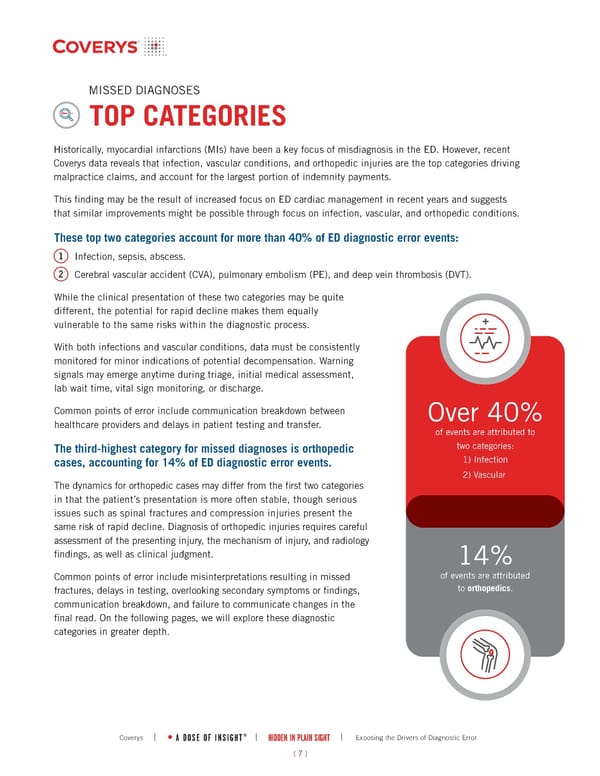( 7 ) These top two categories account for more than 40% of ED diagnostic error events: Infection, sepsis, abscess. Cerebral vascular accident (CVA), pulmonary embolism (PE), and deep vein thrombosis (DVT). While the clinical presentation of these two categories may be quite different, the potential for rapid decline makes them equally vulnerable to the same risks within the diagnostic process. With both infections and vascular conditions, data must be consistently monitored for minor indications of potential decompensation. Warning signals may emerge anytime during triage, initial medical assessment, lab wait time, vital sign monitoring, or discharge. Common points of error include communication breakdown between healthcare providers and delays in patient testing and transfer. The third-highest category for missed diagnoses is orthopedic cases, accounting for 14% of ED diagnostic error events. The dynamics for orthopedic cases may differ from the first two categories in that the patient’s presentation is more often stable, though serious issues such as spinal fractures and compression injuries present the same risk of rapid decline. Diagnosis of orthopedic injuries requires careful assessment of the presenting injury, the mechanism of injury, and radiology findings, as well as clinical judgment. Common points of error include misinterpretations resulting in missed fractures, delays in testing, overlooking secondary symptoms or findings, communication breakdown, and failure to communicate changes in the final read. On the following pages, we will explore these diagnostic categories in greater depth. MISSED DIAGNOSES TOP CATEGORIES 14% of events are attributed to orthopedics. Over 40% of events are attributed to two categories: 1) Infection 2) Vascular Historically, myocardial infarctions (MIs) have been a key focus of misdiagnosis in the ED. However, recent Coverys data reveals that infection, vascular conditions, and orthopedic injuries are the top categories driving malpractice claims, and account for the largest portion of indemnity payments. This finding may be the result of increased focus on ED cardiac management in recent years and suggests that similar improvements might be possible through focus on infection, vascular, and orthopedic conditions. 1 2 | HIDDEN IN PLAIN SIGHT | Exposing the Drivers of Diagnostic Error A DOSE OF INSIGHT ® Coverys |
 Hidden in Plain Sight: Exposing the Drivers of Diagnostic Error Page 7 Page 9
Hidden in Plain Sight: Exposing the Drivers of Diagnostic Error Page 7 Page 9